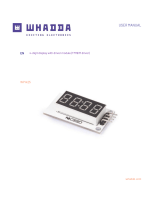Arduino MEGA 2560
Arduino MEGA 2560 is a microcontroller board based on the ATmega2560. It has 54 digital input/output pins (of which 14 can be used as PWM outputs), 16 analog inputs, 4 UARTs (hardware serial ports), a 16 MHz crystal oscillator, a USB connection, a power jack, an ICSP header, and a reset button. It contains everything needed to support the microcontroller; simply connect it to a computer with a USB cable or power it with an AC-to-DC adapter or battery to get started. The Mega is compatible with most shields designed for the Arduino Duemilanove or Diecimila.
Arduino MEGA 2560
Arduino MEGA 2560 is a microcontroller board based on the ATmega2560. It has 54 digital input/output pins (of which 14 can be used as PWM outputs), 16 analog inputs, 4 UARTs (hardware serial ports), a 16 MHz crystal oscillator, a USB connection, a power jack, an ICSP header, and a reset button. It contains everything needed to support the microcontroller; simply connect it to a computer with a USB cable or power it with an AC-to-DC adapter or battery to get started. The Mega is compatible with most shields designed for the Arduino Duemilanove or Diecimila.








-
 1
1
-
 2
2
-
 3
3
-
 4
4
-
 5
5
-
 6
6
-
 7
7
-
 8
8
Arduino MEGA 2560
Arduino MEGA 2560 is a microcontroller board based on the ATmega2560. It has 54 digital input/output pins (of which 14 can be used as PWM outputs), 16 analog inputs, 4 UARTs (hardware serial ports), a 16 MHz crystal oscillator, a USB connection, a power jack, an ICSP header, and a reset button. It contains everything needed to support the microcontroller; simply connect it to a computer with a USB cable or power it with an AC-to-DC adapter or battery to get started. The Mega is compatible with most shields designed for the Arduino Duemilanove or Diecimila.
Ask a question and I''ll find the answer in the document
Finding information in a document is now easier with AI
Related papers
-
Arduino NANO Getting Started
-
Arduino Nano Screw Terminal Adapter Schematics
-
Arduino ATmega328 User manual
-
Arduino DEV-11168 User manual
-
Arduino Ethernet Shield 2 Quick Manual
-
Arduino Uno Application Note
-
Arduino Uno User manual
-
Arduino MKR IoT Carrier Rev2 Schematics
-
Arduino Inventor's Kit Lab Pack - v4.1.2 User guide
-
Arduino Mega2560 User manual
Other documents
-
 MakerFocus MakerFocus 2pcs D1 Mini NodeMcu 4M Bytes Lua WiFi Development Board Base on ESP8266 ESP-12F N Compatible NodeMcu Ar duino User manual
MakerFocus MakerFocus 2pcs D1 Mini NodeMcu 4M Bytes Lua WiFi Development Board Base on ESP8266 ESP-12F N Compatible NodeMcu Ar duino User manual
-
 Orangepip Segments328 How To Program
Orangepip Segments328 How To Program
-
 AlphaWindsim SimHub User manual
AlphaWindsim SimHub User manual
-
Velleman K8200 Operating instructions
-
 SunFounder 8541611892 User manual
SunFounder 8541611892 User manual
-
WHADDA WPSE358 User manual
-
 Geeetech GT2560 User manual
Geeetech GT2560 User manual
-
 SainSmart UNO R3 User manual
SainSmart UNO R3 User manual
-
 WHADDA WPI425 4 Digit Display User manual
WHADDA WPI425 4 Digit Display User manual
-
 WHADDA WPSH202 Arduino Compatible Data Logging Shield User manual
WHADDA WPSH202 Arduino Compatible Data Logging Shield User manual















